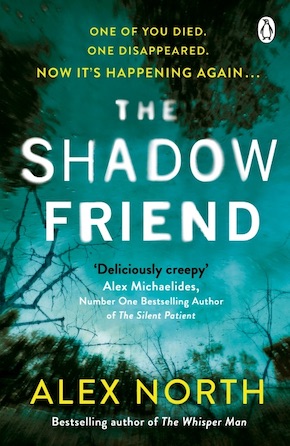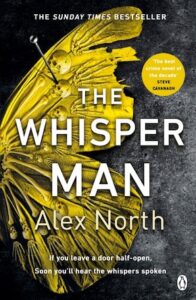Alex North: An intriguing game
by Karin Salvalaggio
“Alex North has outdone himself. The Shadow Friend is the work of a writer who is an absolute master of his craft.” Jane Casey
It was just a silly game to start with. Paul never dreamed that Charlie would take it so far. Never thought it would end in murder…
Twenty years later, Paul is trying to put his past behind him. But now his mother is dying, and he can’t run any longer.
But home isn’t just full of bad memories. It’s also the last place anyone saw Charlie alive.
And Paul starts to wonder if Charlie might come back to finish what he started…
I find myself in the unusual of position of having to rely entirely on the brief description printed on The Shadow Friend’s back cover to avoid spoilers. To reveal any detail beyond those eighty-two words risks giving the game away, and The Shadow Friend is an intriguing game that will have the reader trading one truth for another.
Paul Adams has managed to avoid visiting Gritten Wood for more than twenty years when he’s forced to return home to see his dying mother. He’s sufficiently out of touch to be unaware that she’s been suffering from dementia for quite some time. Their bedside reunion at the hospice is haunting. Paul’s demons are plentiful, but it seems his mother may have accumulated a few her own.
The story unfolds in the same way an image does as a camera backs away from an extreme close-up. Characters and storylines slip in and out of focus as Paul moves between the present and past. His childhood home and surrounding town are a tightly wound jack-in-the-box with a grisly murder festering at its centre. Paul’s teenage mantra persists – You have to do something about Charlie. Where is the boy who continues to haunt his dreams? Is he alive? Is he dead? There have been other murders. Is he still out there pulling strings? Paul’s guilt is, at times, overwhelming. He failed to prevent a tragedy when he was a teenager, and he’s not at all certain he can stay the course as an adult. His first instinct is to run away, his second is to run fast.
The Shadow Friend is an accomplished piece of crime fiction that explores the secrets that people keep from each other, their children and from themselves, and how, over time, those same secrets left unchecked can metastasise in unexpected ways. The dangerous confidences shared by teenagers and suppressed by adults are artfully unwound over the course of the novel. Nothing is as it seems in the inward-looking village of Gritten Wood, with its vast wall of forest locally known as the Shadows. It’s a place where unpleasantness is swept under carpets and stored away in attics, it’s a place where intragenerational trauma is stamped into the DNA…
Karin: At Crimefest, I learned that The Shadow Friend was influenced by the Slender Man stabbing in Wisconsin in 2014. Two twelve-year-old girls stabbed a fellow classmate nineteen times, but luckily the girl survived. Her assailants had become obsessed with a fictitious online character called Slender Man to the point that they believed he was calling to them for a sacrifice. The news coverage of the case and the trial was both extensive and highly sensationalised. Child-on-child murders are thankfully rare. What was it about the case that made you want to explore the Slender Man phenomenon further? What do you think fiction can provide the reader that news coverage cannot?
Alex: I’d start by saying that it wasn’t Slender Man in particular that caught my attention in that case. I know there’s a whole mythology there, but for some reason it’s never interested me that much; something about him/it doesn’t appeal to me the way other fictional monsters do. But I was fascinated by the idea that people could become obsessed with something so obviously unreal to the point they started to believe in it, and that led me to read up a little on folie à deux crimes, where individuals, usually outsiders in some way, develop a shared fantasy world between themselves and end up solidifying it for each other.
That was one of the jumping-off points for the story – the question of what might happen if someone began to manipulate a situation like that. But the characters in The Shadow Friend are a little older, they’re boys, and there are four of them in the group. The actual murder also takes place way back in the past, mostly because I wanted the main character to be revisiting events years later, but also because I wanted to explore the idea that this fictional, fantasy world the boys created had taken on a life of its own in the time since.
In terms of what fiction can provide that news coverage cannot, I suspect there are many, many answers to that. (And vice versa, of course.) The most obvious is some degree of narrative sense and resolution. Real life can be pretty messy, baffling and grim, and we don’t always get the kind of happy ending we want. Even if the ending of a story isn’t entirely happy, there’s usually at least some sense of catharsis. And I suppose tied into that is that fiction allows us to explore difficult and painful subject matter from what amounts to a safe distance.
On a basic level, words matter. So when you use words like cursed, barren, poisonous (etc.), you’re not just describing a scene but also establishing a kind of subconscious palette for the mood and tone of the story.”
The town of Gritten is described as having a gravity that held whatever was dropped where it fell. That included the people. The words cursed, poisonous, barren and dead are employed to draw a fuller picture. The surrounding woods are unnerving and silent and you feel trapped and lost the second you step under the trees. Gritten Park School has murky, monotonous corridors and the classroom doors are thick and heavy, the way [Paul] imagined doors in a prison. The world you’ve painted for your readers is incredibly bleak. Did you have a particular town in mind when you conjured up Gritten Wood? How does such an atmosphere lend itself to creating suspense?
Gritten isn’t based on anywhere in particular, although some of the locations are drawn from places I know – albeit heavily exaggerated for effect. And it is pretty bleak, especially now I see all those descriptions set out like that!
There are two main reasons for that. The first is that I think atmosphere always matters. There’s a familiar saying that it’s harder to do horror in sunlight and, while there are exceptions to that, there’s obviously some truth to it too. On a basic level, words matter. So when you use words like cursed, barren, poisonous (etc.), you’re not just describing a scene but also establishing a kind of subconscious palette for the mood and tone of the story.
And the second reason is because of what the story is about. I needed those four boys to be growing up in an environment from which they would dream – metaphorically and then literally – of escaping. So everything had to be grey and slightly hopeless for them; their lives had to be dull and constrained. There’s a sense of life in Gritten being this endless ongoing present with no real chance of a bright future. So when someone comes along and says, here is a way of getting away from this, you understand why they might take him seriously – or at least want to badly enough to go along with it.
Dream journals and the idea of lucid dreaming feature heavily in the novel. I’ve not googled anything on the subject, so am a complete novice. Were the discussions Paul was having with his friends back in secondary school based on research or was Charlie making it up as he went along? And if this based in reality, could you tell us a bit more about lucid dreaming and a phenomenon you refer to as incubation?
Lucid dreams are when you’re dreaming and realise you are – you wake up in the dream, become aware that what’s happening around you isn’t real, and can take control of it: go anywhere, do anything. I’ve been interested in them for years, and even used to keep a dream diary like the boys do in the book. That’s an effective technique, and can also be quite revealing just for the sake of it: you start to recognise patterns – things you dream about quite often – and it’s interesting to think about why that might be. Dream incubation is also real. The basic idea there is fairly straightforward: your dreams are going to be influenced by things that happen to you in your waking life, so if you want to dream about a certain place (or whatever), you want to be thinking about that place, looking at photos of it, and so on, as often as you can.
Basically, most of what Charlie says in the book is real. The exception is that it’s obviously totally impossible to share dreams with anyone – literally to be in the same dream as someone else. And yet it seems like the boys in the book start to do this, and their dreams become increasingly focused on a shadowy figure they each come to believe in to varying extents. So the question is whether there is something supernatural going on, how and why it’s happening, and where it might lead them.

“The best crime novel of the decade.” Steve Cavanagh
Detective Amanda Beck is a fascinating character. She has to be tough to be a detective, but she’s not quite able to follow her father’s advice and put the awful things she sees away in a box, so you fear for her mental health going forward. She’s haunted by past mistakes and unwilling to compromise. She’s the one character in the book whose arc feels incomplete. I know she featured in The Whisper Man, which is now on the top of my to-be-read pile. Will we be seeing more of her in future novels?
In terms of whether I’ll write about Amanda again, I’m not sure. I generally prefer to write standalones, and she arrived in this book almost by accident. While the underlying idea for the story remained the same, I went through a lot of different drafts and approaches, and the earliest ones didn’t feature a police character at all. When I realised I wanted one, I was planning to start from scratch – but then I remembered where I’d left Amanda at the end of The Whisper Man and thought that, just maybe, I could use her in a way that would give her character some degree of closure. As to whether her arc is complete, your interpretation is obviously as valid as mine, but I was happy enough with where I left her. As you say, at the beginning of the book she’s feeling pretty terrible about being unable to follow her father’s advice and become the kind of police officer he wanted her to be. By the end, without giving anything away, she has resolved that conflict to some degree.
All I can say right now is that she doesn’t feature in the next book. But I enjoy writing her, so never say never. Maybe I’ll need her to come to my rescue again.
In terms of creating and maintaining suspense, I think the most important thing is pretty simple: you need characters you care about who are under threat, and you need to keep that threat unresolved for as long as possible.”
I was struck by how well you handled the different locations, characters and timelines. The reveals are perfectly timed and never feel forced. I’m guessing a bulletin board covered in an elaborate array of Post-it notes, coloured string and index cards isn’t necessarily your style, which makes me want to know how you keep it all straight in your head. Please tell me a little about your writing process. I’d also love to hear about any tips you have on creating and maintaining suspense.
Thank you! One of the best things about writing a book is that the reader only sees the end result, polished to within an inch of its life, and none of the debris and rubble of everything you had to build up and demolish to get there. Basically, I just write lots of drafts. I wish I didn’t have to, but it’s the way it works for me. However much I try to plan, I know the first draft is going to end up being terrible and that I just have to get through that. The book I should have written from the start gradually emerges. I try to think of the first draft as Draft Zero, and there is something freeing about that: yes, it will be bad, but nobody will ever see it, and so you’ve no excuse not to crack on with it.
And this is going to sound nerdy, but once everything begins to come together and I need to keep more careful track of what’s going on – who’s where and when; pacing; order of events – I use an Excel spreadsheet. Colour coded cells. Filters. Cumulative word count. The works. But to be honest, having gone over the book so many times by that point, I usually know it well enough not to need it, so that’s probably just displacement activity on my part.
In terms of creating and maintaining suspense, there are probably loads of craft-level answers to that question, but I think the most important thing is pretty simple: you need characters you care about who are under threat, and you need to keep that threat unresolved for as long as possible. To paraphrase a quote attributed to Hitchcock, a bomb going off in the story might be surprising, but a bomb not going off creates suspense. So put a character you care about next to a bomb – metaphorically – and then stop it from going off for as long as you can. I think that basic principle applies across the board: to short scenes, character arcs and whole novels.
Empathy is the word that most often came to mind when I was reading The Shadow Friend. This may be a work of fiction, but it’s clear that you really care about your characters, the places they come from and the story they’re telling. Paul’s inner world as a teenager and an adult mirror each other perfectly. As a teenager, he’s awkward and anxious but also hopeful for a future beyond Gritten Wood. I found my heart breaking for the man he becomes. Paul the adult is living a life interrupted. He has to go back in order to move forward. I was struck by the authenticity of the teenage voice. Did you keep a journal when you were a teenager, or are you that much younger than me that it feels like yesterday?
Thank you again, because I really appreciate that reaction. Emotion is very important to me, and the works that have stayed with me over the years have usually been ones that made me feel something rather than think something. If there is no emotional resonance to a story then I’m generally not all that interested in writing it. As a reader, I’m happy to be thrilled, scared, biting my fingernails – whatever – but what I really want to be is moved. And while I don’t necessarily care about my characters, as such (I mean, I know they’re not real), what I do care very much about is the emotions, and I always want to do right by the characters on that level.
And what you say about Paul, the main character, is true. Because of what he did – and didn’t do – in the past, part of him has always been trapped there, unable to face up to it but equally unable to move on until he does. And when he comes back to Gritten as his mother is dying, he finds a lot of those old demons waiting for him. When it came to the teenage voice, I really just did my best. The way I thought about it was that you’re reading Paul’s recollections, looking back on events as a grown-up, so if the voice occasionally came across as being more adult it wouldn’t be the end of the world. But I didn’t keep a journal as a teenager or anything like that, which I’m quite grateful for. I remember myself as a teenager, and I can’t think of anything that would be more cringeworthy to look back on now!
Last but by no means least, what are you working on now?
Right now, I’m working on ideas for the fourth Alex North book. The next one is already finished and will be published early next year. It was written during lockdown, which I found a weird time to work in – I had things incredibly easy in the grand scheme of things, but for some reason writing became pretty difficult. Everything felt very slow and stagnant. So this book went through even more drafts than usual. I’m still a little close to it right now, but I think I’m happy with where it’s ended up. And in this case, I’m especially glad nobody will see all the debris I accumulated along the way…
 Alex North was born in Leeds, where he now lives with his wife and son. He studied Philosophy at Leeds University, where he worked in the Sociology department prior to becoming a writer. Having published eleven mystery/suspense novels under another name, his first Alex North book The Whisper Man (2019) was a Sunday Times and New York Times bestseller, and published in over 30 languages. The Shadow Friend is published by Penguin in paperback, eBook and audio download. The Half-Burnt House is forthcoming from Michael Joseph.
Alex North was born in Leeds, where he now lives with his wife and son. He studied Philosophy at Leeds University, where he worked in the Sociology department prior to becoming a writer. Having published eleven mystery/suspense novels under another name, his first Alex North book The Whisper Man (2019) was a Sunday Times and New York Times bestseller, and published in over 30 languages. The Shadow Friend is published by Penguin in paperback, eBook and audio download. The Half-Burnt House is forthcoming from Michael Joseph.
Read more
@writer_north
@PenguinUKBooks
 Karin Salvalaggio is the author of the Macy Greeley crime novels Bone Dust White, Burnt River, Walleye Junction and Silent Rain and a contributing editor at Bookanista. Her fiction to date is set in towns that border the Montana’s wilderness, a uniquely spectacular landscape she fell in love with as a child. Her proudly independent characters inhabit stories about the American dream gone wrong. She is currently working on a crime novel set in California. Jessica Carson has returned to her conservative roots after working as a cop in Berkeley, one of America’s most liberal cities. The transition is not without difficulties. The police detective she’s replacing was involved in the 6 January riots and her estranged son has become immersed in Antifa.
Karin Salvalaggio is the author of the Macy Greeley crime novels Bone Dust White, Burnt River, Walleye Junction and Silent Rain and a contributing editor at Bookanista. Her fiction to date is set in towns that border the Montana’s wilderness, a uniquely spectacular landscape she fell in love with as a child. Her proudly independent characters inhabit stories about the American dream gone wrong. She is currently working on a crime novel set in California. Jessica Carson has returned to her conservative roots after working as a cop in Berkeley, one of America’s most liberal cities. The transition is not without difficulties. The police detective she’s replacing was involved in the 6 January riots and her estranged son has become immersed in Antifa.
karinsalvalaggio.com
Karin on Bookanista
@KarinSalvala

